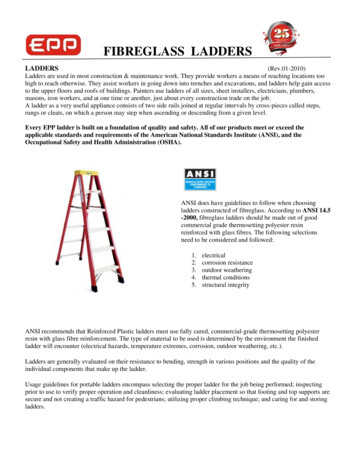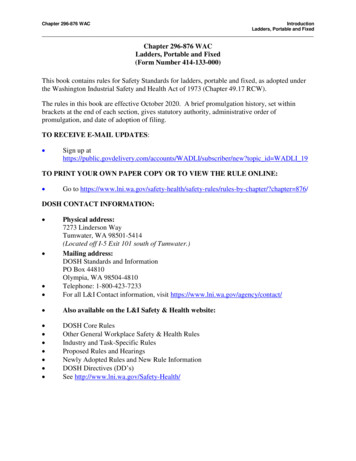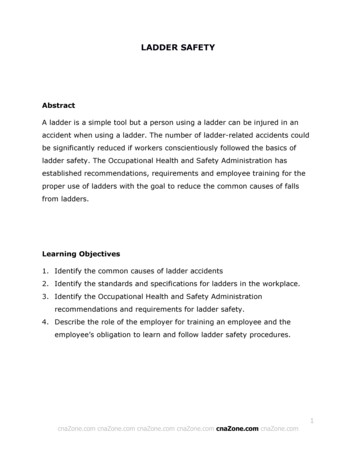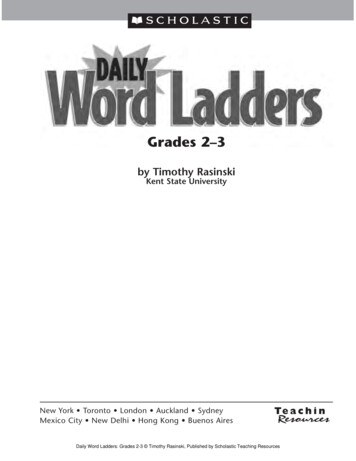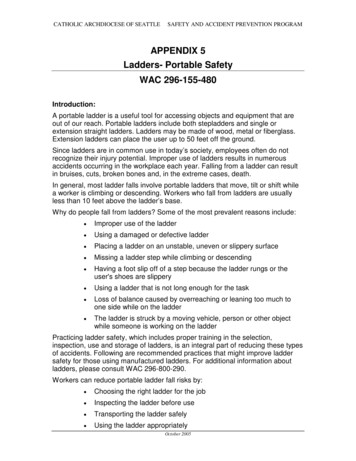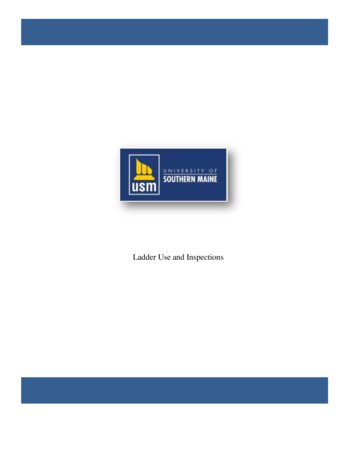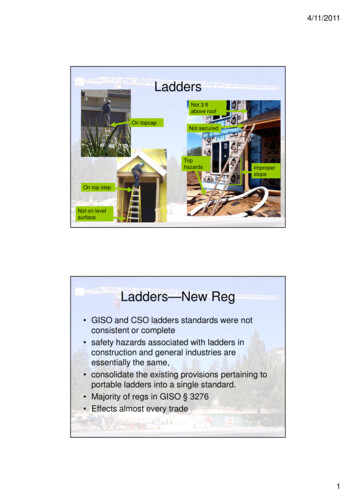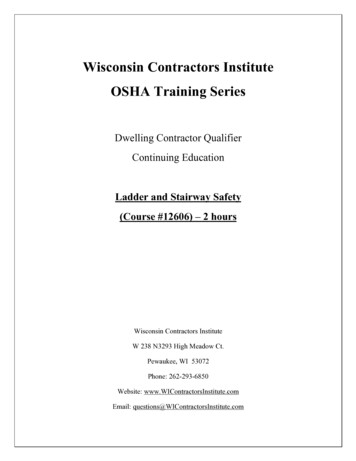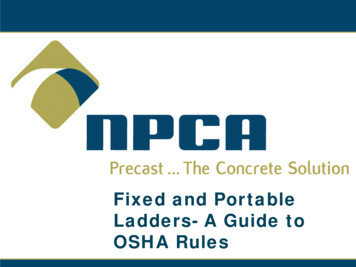
Transcription
Fixed and PortableLadders- A Guide toOSHA Rules
IntroductionWorking on and around stairways and ladders ishazardous. Stairways and ladders are major sources ofinjuries and fatalities among construction workers forexample, and many of the injuries are serious enough torequire time off the job. OSHA rules apply to all stairwaysand ladders used in construction, alteration, repair,painting, decorating and demolition of worksites coveredby OSHA’s construction safety and health standards.
General RequirementsThese rules specify when employers must providestairways and ladders. In general, the standards requirethe following: When there is a break in elevation of 19 inches (48cm) or more and no ramp, runway, embankment orpersonnel hoist is available, employers must providea stairway or ladder at all worker points of access.
General RequirementsThese rules specify when employers must providestairways and ladders. In general, the standards requirethe following: When there is only one point of access betweenlevels, employers must keep it clear of obstacles topermit free passage by workers. If free passagebecomes restricted, employers must provide asecond point of access and ensure that workers useit.
General RequirementsThese rules specify when employers must providestairways and ladders. In general, the standards requirethe following: When there are more than two points of accessbetween levels, employers must ensure that at leastone point of access remains clear.
General RequirementsIn addition, employers must install all stairway and ladderfall protection systems required by these rules and ensurethat their worksite meets all requirements of the stairwayand ladder rules before employees use stairways orladders. See 29 CFR 1926.1050-1060 for the details ofthe standard.Note: The standard does not apply to ladders specificallymanufactured for scaffold access and egress, but does apply to jobmade and manufactured portable ladders intended for generalpurpose use. Rules for ladders used on or with scaffolds areaddressed in 29 CFR 1926.451 Subpart L.
Rules for LaddersThe following rules apply to all ladders: Maintain ladders free of oil, grease and otherslipping hazards.Do not load ladders beyond their maximum intendedload nor beyond their manufacturer’s rated capacity.Use ladders only for their designed purpose.
Rules for LaddersThe following rules apply to all ladders: Use ladders only on stable and level surfacesunless secured to prevent accidental movement.Do not use ladders on slippery surfaces unlesssecured or provided with slip-resistant feet toprevent accidental movement.Do not use slip resistant feet as a substitute forexercising care when placing, lashing or holding aladder upon slippery surfaces.
Rules for LaddersThe following rules apply to all ladders: Secure ladders placed in areas such aspassageways, doorways or driveways, or wherethey can be displaced by workplace activities ortraffic to prevent accidental movement. Or use abarricade to keep traffic or activity away from theladder.Keep areas clear around the top and bottom ofladders.
Rules for LaddersThe following rules apply to all ladders: Do not move, shift or extend ladders while in use.Use ladders equipped with nonconductive side railsif the worker or the ladder could contact exposedenergized electrical equipment.Face the ladder when moving up or down.Use at least one hand to grasp the ladder whenclimbing.Do not carry objects or loads
Rules for LaddersIn addition, the following general requirements apply to allladders, including ladders built at the jobsite: Double-cleated ladders or two or more ladders mustbe provided when ladders are the only way to enteror exit a work area where 25 or more employeeswork or when a ladder serves simultaneous two-waytraffic.Ladder rungs, cleats and steps must be parallel,level and uniformly spaced when the ladder is inposition for use.
Rules for LaddersIn addition, the following general requirements apply to allladders, including ladders built at the jobsite: Rungs, cleats and steps of portable and fixedladders (except as provided below) must not bespaced less than 10 inches (25 cm) apart, not morethan 14 inches (36 cm) apart, along the ladder’sside rails.Rungs, cleats and steps of step stools must not beless than 8 inches (20 cm) apart, nor more than 12inches (31 cm) apart, between center lines of therungs, cleats and steps.
Rules for LaddersIn addition, the following general requirements apply to allladders, including ladders built at the jobsite: Rungs, cleats and steps at the base section ofextension trestle ladders must not be less than 8inches (20 cm) nor more than 18 inches (46cm)apart, between center lines of the rungs, cleats andsteps. The rung spacing on the extension sectionmust not be less than 6 inches (15 cm) nor morethan 12 inches (31 cm).
Rules for LaddersIn addition, the following general requirements apply to allladders, including ladders built at the jobsite: Ladders must not be tied or fastened together tocreate longer sections unless they are specificallydesigned for such use.When splicing side rails, the resulting side rail mustbe equivalent in strength to a one-piece side railmade of the same material.
Rules for LaddersIn addition, the following general requirements apply to allladders, including ladders built at the jobsite: Two or more separate ladders used to reach anelevated work area must be offset with a platform orlanding between the ladders, except when portableladders are used to gain access to fixed ladders.
Rules for LaddersIn addition, the following general requirements apply to allladders, including ladders built at the jobsite: Ladder components must be surfaced to preventsnagging of clothing and injury from punctures orlacerations.Wood ladders must not be coated with any opaquecovering except for identification or warning labels,which may be placed only on one face of a side rail.A competent person must inspect ladders for visibledefects periodically and after any incident that couldaffect their safe use.
Specific Types of LaddersDo not use single-rail ladders.Use non-self-supporting ladders at an angle where thehorizontal distance from the top support to the foot of theladder is approximately one-quarter of the working lengthof the ladder.
Specific Types of LaddersUse wooden ladders built at the jobsite with spliced siderails at an angle where the horizontal distance is oneeighth of the working length of the ladder.In addition, the top of a non-self-supporting ladder mustbe placed with two rails supported equally unless it isequipped with a single support attachment.
StepladdersDo not use the top or top step of a stepladder as a step.Do not use cross bracing on the rear section ofstepladders for climbing unless the ladders are designedand provided with steps for climbing on both front andrear sections.Metal spreader or locking devices must be provided onstepladders to hold the front and back sections in an openposition when ladders are being used.
Portable LaddersThe minimum clear distance between side rails for allportable ladders must be 11.5 inches (29 cm).In addition, the rungs and steps of portable metal laddersmust be corrugated, knurled, dimpled, coated with skidresistant material or treated to minimize slipping.
Portable LaddersNon-self-supporting and self-supporting portable laddersmust support at least four times the maximum intendedload; extra heavy-duty type 1A metal or plastic laddersmust sustain 3.3 times the maximum intended load.To determine whether a self-supporting ladder cansustain a certain load, apply the load to the ladder in adownward vertical direction with the ladder placed at ahorizontal angle of 75.5 degrees
Portable LaddersWhen portable ladders are used for access to an upperlanding surface, the side rails must extend at least 3 feet(.9 m) above the upper landing surface.When such an extension is not possible, the ladder mustbe secured and a grasping device such as a grab railmust be provided to assist workers in mounting anddismounting the ladder.A ladder extension must not deflect under a load thatwould cause the ladder to slip off its supports.
Fixed LaddersIf the total length of the climb on a fixed ladder equals orexceeds 24 feet (7.3 m), the ladder must be equippedwith ladder safety devices; or self-retracting lifelinesand rest platforms at intervals not to exceed 150 feet(45.7 m); or a cage or well and multiple ladder sectionswith each ladder section not to exceed 50 feet (15.2 m) inlength.
Fixed LaddersThese ladder sections must be offset from adjacentsections and landing platforms must be provided atmaximum intervals of 50 feet (15.2 m). In addition, fixedladders must meet the following requirements:
Fixed LaddersFixed ladders must be able to support at least two loadsof 250 pounds (114 kg) each, concentrated between anytwo consecutive attachments. Fixed ladders also mustsupport added anticipated loads caused by ice buildup,winds, rigging and impact loads resulting from usingladder safety devices.
Fixed LaddersIndividual rung/step ladders must extend at least 42inches (1.1 m) above an access level or landing platformeither by the continuation of the rung spacings ashorizontal grab bars or by providing vertical grab bars thatmust have the same lateral spacing as the vertical legs ofthe ladder rails.
Fixed LaddersEach step or rung of a fixed ladder must be able tosupport a load of at least 250 pounds (114 kg) applied inthe middle of the step or rung.Minimum clear distance between the sides of individualrung/step ladders and between the side rails of otherfixed ladders must be 16 inches (41 cm).
Fixed LaddersRungs of individual rung/step ladders must be shaped toprevent slipping off the end of the rungs.Rungs and steps of fixed metal ladders manufacturedafter March 15, 1991, must be corrugated, knurled,dimpled, coated with skid-resistant material or treated tominimize slipping.Minimum perpendicular clearance between fixed ladderrungs, cleats, and steps and any obstruction behind theladder must be 7 inches (18 cm), except that theclearance for an elevator pit ladder must be 4.5 inches(11 cm).
Fixed LaddersMinimum perpendicular clearance between the centerlineof fixed ladder rungs, cleats and steps, and anyobstruction on the climbing side of the ladder must be 30inches (76 cm). If obstructions are unavoidable, clearancemay be reduced to 24 inches (61 cm), provided adeflection device is installed to guide workers around theobstruction.
Fixed LaddersStep-across distance between the center of the steps orrungs of fixed ladders and the nearest edge of a landingarea must be no less than 7 inches (18 cm) and no morethan 12 inches (30 cm). A landing platform must beprovided if the step-across distance exceeds 12 inches(30 cm).
Fixed LaddersFixed ladders without cages or wells must have at least a15-inch (38 cm) clearance width to the nearest permanentobject on each side of the centerline of the ladder.Fixed ladders must be provided with cages, wells, laddersafety devices or self-retracting lifelines where the lengthof climb is less than 24 feet (7.3 m) but the top of theladder is at a distance greater than 24 feet (7.3 m) abovelower levels.
Fixed LaddersSide rails of through or side-step fixed ladders mustextend 42 inches (1.1 m) above the top level or landingplatform served by the ladder. Parapet ladders must havean access level at the roof if the parapet is cut to permitpassage through it. If the parapet is continuous, theaccess level is the top of the parapet.
Fixed LaddersSteps or rungs for through-fixed-ladder extensions mustbe omitted from the extension; and the extension of siderails must be flared to provide between 24 inches (61 cm)and 30 inches (76 cm) clearance between side rails.When safety devices are provided, the maximumclearance distance between side rail extensions must notexceed 36 inches (91 cm).Fixed ladders must be used at a pitch no greater than 90degrees from the horizontal, measured from the back sideof the ladder.
Defective LaddersLadders needing repairs are subject to the followingrules: Portable ladders with structural defects—such asbroken or missing rungs, cleats or steps, broken orsplit rails, corroded components or other faulty ordefective components—must immediately bemarked defective or tagged with "Do Not Use" orsimilar language and withdrawn from service untilrepaired.
Defective LaddersLadders needing repairs are subject to the followingrules: Fixed ladders with structural defects—such asbroken or missing rungs, cleats or steps, broken orsplit rails or corroded components— must bewithdrawn from service until repaired.
Defective LaddersLadders needing repairs are subject to the followingrules: Defective fixed ladders are considered withdrawnfrom use when they are immediately tagged with"Do Not Use" or similar language, or marked in amanner that identifies them as defective, orblocked—such as with a plywood attachment thatspans several rungs.Ladder repairs must restore the ladder to acondition meeting its original design criteria beforethe ladder is returned to use.
Training RequirementsEmployers must train all employees to recognize hazardsrelated to ladders and stairways, and instruct them tominimize these hazards. For example, employers mustensure that each employee is trained by a competentperson in the following areas, as applicable: Nature of fall hazards in the work areaCorrect procedures for erecting, maintaining anddisassembling the fall protection systems to be usedProper construction, use, placement and care inhandling of all stairways and ladders
Training RequirementsEmployers must train all employees to recognize hazardsrelated to ladders and stairways, and instruct them tominimize these hazards. For example, employers mustensure that each employee is trained by a competentperson in the following areas, as applicable: Maximum intended load-carrying capacities ofladders used.Note: Employers must retrain each employee as necessary tomaintain their understanding and knowledge on the safe use andconstruction of ladders and stairs.
Portable Ladders Non-self-supporting and self-supporting portable ladders must support at least four times the maximum intended load; extra heavy-duty type 1A metal or plastic ladders must sustain 3.3 times the maximum intended load.
